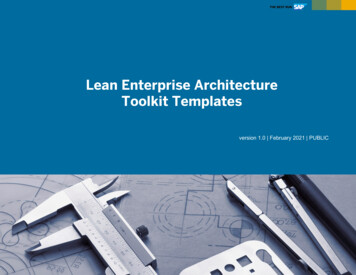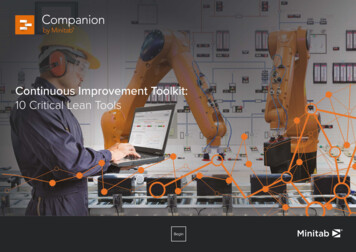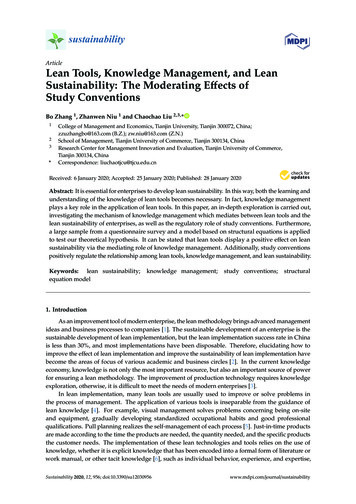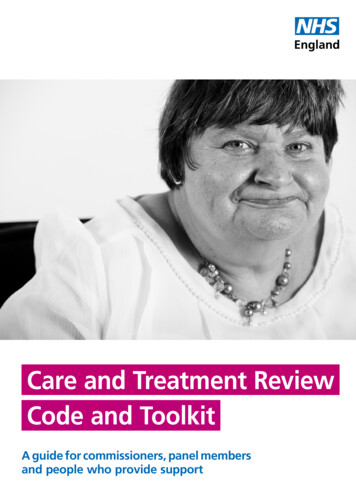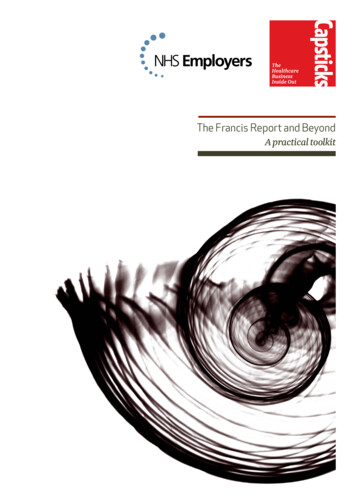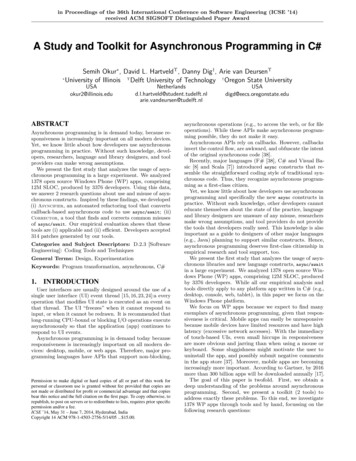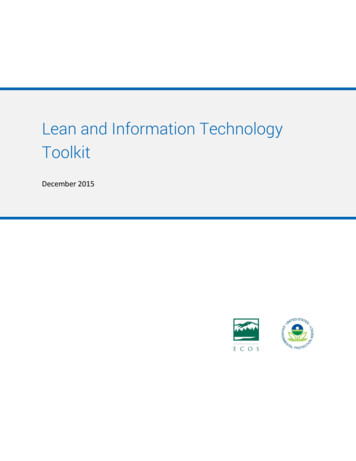
Transcription
Lean and Information TechnologyToolkitDecember 2015
AcknowledgmentsThe U.S. Environmental Protection Agency (EPA) and the Environmental Council of the States (ECOS) are gratefulfor the valuable assistance of the individuals who helped develop this Lean and Information Technology Toolkitand shared experiences and ideas using Lean along with technology to improve agency programs and processes.This Toolkit has benefited from the collective expertise of many individuals across state agencies and EPAprogram areas who are familiar with Lean and process-improvement projects. In particular, EPA and ECOS wouldlike to thank the following individuals for their thoughtful contributions: Sue Battle-McDonald (State Co-chair), Maryland Department of the Environment Scott Bowles (EPA Co-chair), EPA Office of Policy Scott Baird, Utah Department of Environmental Quality Tim Cooke, Wisconsin Department of Natural Resources Marjorie Damgaard, Wisconsin Department of Natural Resources Linda Darveau, EPA Region 1 Katherine Dawes, EPA Office of Policy Beth Graves, Environmental Council of the States Amanda Halstead, EPA Region 7 Martha Hankins, Washington State Department of Ecology Shana Harbour, EPA Office of the Chief Financial Officer Ann Lowery, Massachusetts Department of Environmental Protection Nicole Lugli, Connecticut Department of Energy & Environmental Protection Bob Minicucci, New Hampshire Department of Environmental Services David Nicholas, EPA Office of Solid Waste and Emergency Response Victoria Phillips, Massachusetts Department of Environmental Protection Andrew Putnam, Colorado Department of Public Health and Environment Tamara Saltman, EPA Office of Air and Radiation Chris Taylor, EPA Region 7 Tegan Vaughn, EPA Region 7 Phil Warren, EPA Region 1 Heather Weir, Colorado Department of Public Health and EnvironmentKristen Durance, Megan Parker, Louis Sweeny, and Jennifer Tice of Ross Strategic (www.rossstrategic.com)prepared this toolkit for EPA under subcontract to ICF International (EP-W-11-017/0006).Lean and IT Toolkit
Table of ContentsExecutive Summary.1Chapter 1: Introduction .5Background and Purpose of This Toolkit . 5Benefits of Lean and IT for Environmental Agencies. 7Toolkit Organization . 8Chapter 2: Lean Startup.9What Is Lean Startup? . 9How Does Lean Startup Differ from Lean Process-Improvement Methods? . 11What Is a “Minimum Viable Product”? . 12Why Is Lean Startup Useful for Projects with Highly Uncertain Outcomes? . 13Chapter 3: How to Plan for Process Streamlining and Process Modernization Projects . 151. Understand the Problem . 152. Develop a Manageable Scope for Lean and IT Process-Improvement Efforts . 163. Assemble a Project Team with the Right Mix of Leadership, Facilitation, and IT Support . 184. Sequence Improvements to Streamline Processes Before Automating Them . 195. Identify Other IT Impacts That Could Affect the Project . 20Chapter 4: How to Improve Processes with Lean and IT . 231. Develop a Robust, Data-Driven Understanding of the Current Process . 232. Take a “Creativity Before Capital” Approach to Process Improvement . 243. Consider Ways IT Solutions Can Enhance Lean Outcomes. 264. Engage Stakeholders and Customers Early and Often . 275. Develop a Clear Implementation Plan for Future Lean and IT Improvements . 28Chapter 5: How to Effectively Follow Up from Lean and IT Process-Improvement Projects . 311. Track Action Items and Make Project Teams Accountable for Making Progress . 312. Closely Coordinate IT Development Efforts with Implementation of the New Process . 323. Evaluate Process Performance and the Need to Make Additional Changes . 33Chapter 6: Agile Methodology . 35What Is Agile? . 35The Agile Development Process . 36How Is Agile Helpful for IT Development? . 37Lean and IT Toolkit
Chapter 7: Strategies and Tips for Multi-Agency Collaboration on Lean and ITImprovement Projects. 39Benefits of Agency Collaboration to Improve Processes and Programs . 39Collaboration Strategies and Tips . 40Chapter 8: Conclusion . 43Appendix A: More Information on Lean . 45What Is Lean? . 45Appendix B: Lean Government, Lean IT, and E-Enterprise Resources . 48Appendix C: Case Studies . 51Case Study: Massachusetts Department of Environmental Protection Enterprise-wide DataManagement System. 51Case Study: Wisconsin Department of Natural Resources Water Program E-Permitting SystemDevelopment Process Description . 56Case Study: EPA Region 1 Improvements to the Lab Purchasing Process . 60Case Study: EPA Region 7 Improvements to the Concentrated Animal Feeding OperationInspection Reporting Process . 63Appendix D: Lean Charter Template . 68Appendix E: Lean Implementation Plan Template . 71Lean and IT Toolkit
Executive SummaryEnvironmental agencies across the United States are finding better, faster, and more efficient ways to addressenvironmental management challenges. Lean and information technology (IT) are two important ways thatenvironmental agencies are transforming how they protect human health and the environment. Lean is animprovement approach and set of methods that eliminate non-value added activity or “waste.” New ITapproaches can help agencies to streamline, modernize, and expand the services they provide to customers.This Lean and IT Toolkit explores how Lean and IT can be used to accomplish the following: Efficiently design new products and services to better meet customer needs (Lean Startup) Improve the efficiency and effectiveness of existing processes (Lean process improvement) Reduce the costs and risks of developing new IT products (Agile development)This Toolkit provides how-to guidance, resources, and tips for making improvements in each of theseapplications of Lean and IT (product conceptualization, process improvement, and IT product development), aswell as describes how agencies can collaborate effectively on improvement projects.Lean and IT Project Results Wisconsin Department of Natural Resources used Lean thinking and process mapping to streamlinethe permit application process for the Water Program, cutting the time for general and individualpermit reviews by about 50%. The agency then developed an e-permitting system to further enhancepermit response time and provide better information to regulated entities. Massachusetts Department of Environmental Protection is developing an enterprise-wide datamanagement system to support permitting, compliance, and enforcement operations. MassDEP usedLean thinking to document current practices, identify opportunities to streamline, and simplifyprocesses in anticipation of constructing an e-permitting module. This process resulted incategorizing over 300 permits into eight permit “families” to support the e-permitting system. EPA Region 1 employed Lean and IT strategies to reduce the time to complete lab-purchasing ordersby 60%, eliminate 40% of the steps in the process, institute an automatic reordering process whensupplies are low, and develop a new electronic form and record-keeping system. The agency is alsoinstituting a SharePoint workflow tracking system to support the new process. EPA Region 7 improved the quality and timeliness of the concentrated animal feeding operation(CAFO) inspection process through Lean and IT improvements. This included reducing the time tocomplete CAFO inspections by 25% when sampling was required and by 40% when no sampling wasneeded, enabling online coordination of electronic draft reports with a new SharePoint site, anddeveloping a spreadsheet to track key performance indicators and timelines for inspections.This Toolkit contains case studies of each of these projects.Executive Summary Page 1
Benefits of Lean and IT for Environmental AgenciesEnvironmental agencies have used Lean to speed process times, eliminate backlogs, improve product quality,provide more value to customers, and free staff time to work on other activities. IT solutions amplify these gainsby automating streamlined processes, incorporating automated error checks to improve quality, enhancing theability to share data across organizations, and providing better information for decision-makers. Lean Startupand Agile methods also allow agencies to design and develop new products and IT solutions to meet customerneeds while minimizing the risks and costs of product development.Lean Startup: Design or Redesign Products or ServicesLean Startup, first conceptualized by Eric Ries, is the use of Lean concepts to determine what products orservices to develop to meet customer needs in conditions of high uncertainty. The Lean Startup approachminimizes the time and costs of product development through the following, iterative process: Identify ways to deliver value to customers through new or redesigned products or services Develop minimum viable products – components of a new approach that can be tested in the real world Learn from how customers engage with the minimum viable products, and adapt plans for the productor service based on user dataEnvironmental agencies could consider using the Lean Startup approach when there is a need for new orfundamentally redesigned products or services to meet customer needs and when there is little known aboutwhat would be most useful to customers.Lean Process Improvement: Reduce Waste to Optimize Existing ProcessesFor existing processes, Lean and IT can work together to increase efficiency and enhance effectiveness. Keyprinciples for combining Lean and IT to support process-improvement projects include the following: Involve IT personnel in all stages of processimprovement projects, at least on a consulting basis, tohelp plan projects, identify IT strategies that couldaddress process problems, and, where applicable,develop and implement IT changes in the context ofother process changes.Use creativity before capital to solve problems;maximize improvements you can make to your processwith simple, cheap changes, and then consider whetherto invest more resources to deliver additionalperformance benefits.Streamline processes before automating them;otherwise, there is the possibility of locking in orexacerbating errors and inefficiency in the process.Executive Summary Page 2Tips for Multi-Agency Collaborationon Lean and IT Improvement Projects Coordinate with agencies early on Limit the size of Lean projectteams Establish lines of accountability atdifferent agencies Be flexible and consider agencydifferences when designingsolutions and planningimplementation
Closely coordinate implementation of IT and other changes, tracking the status of action items,identifying and addressing issues early on, evaluating process performance, and recalibrating effortswhen necessary.This Toolkit outlines how-to steps, tips, and resources for planning and executing Lean and IT processimprovement projects based on these key principles.Agile Development: Use an Iterative Process to Develop IT Solutions More EfficientlyUnlike traditional, linear “waterfall” methods for software development, Agile uses a streamlined, iterativeprocess for developing IT solutions to meet customer needs. Agile development relies on the following: Short, team-based “sprints” of activity to develop components of technology Frequent collection of customer feedback on technology components during the development process(rather than waiting until the full product is developed) Adapting the technology requirements and plans based on feedbackBy iterating development and collecting user feedback early on, Agile teams are better able to focus their effortson what matters most for the users. Agile offers a powerful new way for environmental agencies to develop ITsolutions using less time and resources. Agile is often used in Lean Startup to help develop minimum viableproducts when there is less certainty around what IT product is needed.Lean and IT Going ForwardThis Toolkit complements a series of Lean resources available from EPA and other agencies, including EPA’s Leanin Government Starter Kit. Taken together, these documents can help environmental agencies in their efforts tooperate more efficiently and effectively to protect human health and the environment. The practice of usingLean methods with technology solutions to improve agency programs and processes is relatively new. Weenvision this Toolkit to be a living document that can be updated over time to reflect best practices, resources,and examples that emerge as environmental agencies use these techniques to achieve the next level ofimproved environmental performance, customer service, and efficiency.Executive Summary Page 3
This page is intentionally blank.Executive Summary Page 4
Chapter 1: IntroductionBackground and Purpose of This ToolkitThis Toolkit was developed as part of E-Enterprise for theEnvironment initiative (see box) to help environmental agenciesintegrate Lean with new information technology (IT) approaches thatstreamline, modernize, and expand the services they provide tocustomers. Lean is an improvement approach and set of methods thatcan dramatically enhance the speed, quality, and transparency ofprocesses by eliminating non-value added activity or “waste,” therebyfocusing efforts on high-value outcomes.IN THIS CHAPTER1. Background and Purpose of ThisToolkit2. Benefits of Lean and IT forEnvironmental Agencies3. Toolkit OrganizationThis Toolkit provides best practices, guidance, and resources that canhelp your agency integrate IT improvements while improving the efficiency and effectiveness of programs andprocesses. It is designed to help your agency understand how to accomplish the following: Use appropriate Lean tools to find better ways to deliver value to customers and make efficient ITinvestments. Streamline the development of IT solutions. Identify and plan Lean and IT improvements to address problems in your processes. Implement process-improvement approaches effectively.E-Enterprise for the Environment(E-Enterprise)Launched in 2014, E-Enterprise is a newmodel for collaborative leadershipamong environmental co-regulators andaffected parties to achieve positiveenvironmental, human health, andeconomic outcomes. The E-EnterpriseInitiative is streamlining andmodernizing the implementation of ourenvironmental programs.With E-Enterprise, environmentalagencies have the opportunity to learnfrom each other, apply Lean and IT at anagency and cross-agency level, andaccess shared technology resources.Chapter 1: Introduction Page 5Lean is not the only approach for quality and productivityimprovements, but many environmental agencies have foundsuccess with it. The Toolkit highlights the following methods: Lean Startup: A rapid, efficient approach to determining whatnew products or services to develop that meet customerneeds Lean Process Improvement: Structured methods foreliminating non-value added activity, including delays, errors,and other inefficiencies, from work processes, therebydelivering more value to customers Agile or Lean Software Development: Techniques and toolsthat allow IT staff to work in an iterative, streamlined fashionto develop a technology solution for an identified customerneedThese three Lean approaches are appropriate for solving differentkinds of problems, as shown in Figure 1. For those with high
uncertainty and/or before a process is in place, Lean Startup can be used. For existing processes that need to beimproved, agencies can use traditional Lean thinking and methods to reduce wastes and provide more value tocustomers. When an IT need is more certain, Agile helps integrate Lean thinking into the IT developmentprocess. This high-level conceptualization provides guidance when each of these methodologies may be used,but in practice, these methods are often combined with each other.Figure 1: Toolkit FrameworkThis Toolkit is intended to complement existing resources describing the use of Lean by environmental agencies,including EPA’s Lean in Government Starter Kit. This Toolkit expands upon those resources by providing how-toguidance and resources for how environmental agencies can combine Lean with IT, as well as collaborateeffectively, to improve agency programs and processes. This Toolkit assumes basic familiarity with Leanconcepts, but additional information and resources on Lean can be found in Appendices A and B.Chapter 1: Introduction Page 6
Benefits of Lean and IT for Environmental AgenciesIntegrating IT strategies with Lean improvements accelerates andexpands their impact. When applied to streamlined processes, IT“The first rule of any technology used in ais even more effective at helping agencies optimize performancebusiness is that automation applied to anand share information internally and with stakeholders and theefficient operation will magnify thepublic. The use of Lean techniques can improve enterpriseefficiency. The second is that automationtechnology development and operation by increasing the speedapplied to an inefficient operation willand quality of development and by providing resource efficiencymagnify the inefficiency.”– Bill Gatesat the agency level. Lean includes talking to customers, listeningto concerns, and delivering products and services to meetcustomer needs identified for business processes. Lean does thisthrough collaborative, team-based activities that have the following characteristics: Focus prioritization and action in tight periods Rely on data about how processes actually work Emphasize high-impact, simple solutions over expensive,time-consuming process changesIT capabilities such as mobile data collection, shared files, andauto-error checking in forms, among others, can enhance andfurther streamline business processes. Through techniques suchas Agile development, Lean can also increase the efficiency ofand collaboration on IT development while mitigating overall riskand maximizing the efficiency of resources. Techniques like LeanStartup help mitigate uncertainty in complex IT projects andprovide a method for quickly starting on key aspects of a projectwithout diving head first into full product development.Benefits of Lean and ITAgencies using Lean and IT can expect tosee one or more of these benefits: Eliminate or dramatically reducebacklogs Reduce lead times by more than 50percent Decrease the complexity ofprocesses and eliminate unneededprocess steps Improve the quality and consistencyof work products and activities Allocate more staff time to “missioncritical” work Improve staff morale Enhance process transparency tointernal and external audiencesMany environmental agencies have used Lean successfully toproduce significant results for IT projects. These Lean projectshave helped agencies to speed process times, free staff time,eliminate unnecessary process steps, and improve quality of products, as well as improved IT services. Agencieslike the Government Services Administration (GSA) are starting to build guidelines for technology developmentusing Lean principles as well. Appendix C of this Toolkit contains case studies describing the experiences, results,and lessons learned from Lean and IT projects at the following agencies: Massachusetts Department of Environmental Protection Wisconsin Department of Natural Resources EPA Region 1 EPA Region 7Chapter 1: Introduction Page 7
Toolkit OrganizationThis Toolkit is appropriate for both Lean practitioners who are looking for guidance on how to use Lean toimprove processes that may have an IT component and agency personnel who have identified a need for atechnology solution to address a particular problem. For the latter, Lean tools can provide a roadmap to ensurethe most efficient and effective deployment of technology solutions. The remainder of this toolkit is organizedaround the following questions: Chapter 2: What is Lean Startup?o Chapters 3, 4 and 5: How do I plan for, conduct, and implement Lean and IT solutions to solve problems inmy process?o Appendix C contains case studies of EPA and state Lean and IT process-improvement projects. Thecase studies describe the project activities and the results they achieved.Appendix D (Lean Charter Template)o Appendix B contains a compilation of resources for learning more about Lean government, EEnterprise, Lean Startup, and Agile development.Appendix C (Case Studies): How have environmental agencies used Lean and IT solutions to improve theirprocesses?o Appendix A contains more information on Lean and key Lean methods.Appendix B (Resources): How can I learn more?o The information in this chapter highlights key lessons learned and tips based on experience gatheredfrom Lean and IT improvement projects involving multiple agencies.Appendix A (Background on Lean): What is Lean?o This chapter provides an overview of Agile methodology and its application for IT development. Thischapter is particularly valuable for IT departments and staff seeking faster, cheaper, and less riskyways to develop IT solutions.Chapter 7: What are the best practices for collaborating on Lean and IT improvement projects withmultiple agencies?o These chapters provide specific guidance for each phase of the process-improvement projects fromplanning, conducting Lean projects, implementing process changes, and follow-up. A particularemphasis is placed on when and how to coordinate and integrate IT solutions within Lean methodssuch as “kaizen” rapid process improvement events.Chapter 6: What is Agile?o This chapter introduces Lean Startup and potential applications for designing new products,including IT projects, at environmental agencies.Appendix D contains a Lean charter template that may be used to clarify and promoteunderstanding of the scope, goals, and expectations for Lean process-improvement projects.Appendix E (Lean Implementation Plan Template)oAppendix E contains a template and an example of a Lean project implementation plan that may beused to identify and track action items from process-improvement projects.Chapter 1: Introduction Page 8
Chapter 2: Lean StartupIn this chapter, we discuss a powerful new application of Leancalled Lean Startup, which can allow agencies to determinewhat new products or services (including IT solutions) todevelop to meet customer needs while minimizing the costsand risks of new product development. Lean Startup cancomplement strategies for improving existing processes withLean and IT (chapters 3-5) and/or developing defined ITsolutions (chapter 6).IN THIS CHAPTER1. What Is Lean Startup?2. How Does Lean Startup Differ fromLean Process-Improvement Methods?3. What Is a “Minimum Viable Product”?4. Why Is Lean Startup useful for Projectswith Highly Uncertain Outcomes?What Is Lean Startup?Lean Startup is a methodology developed by Eric Ries that guides new projects through the discovery andcreation process quickly while taking advantage of innovation that is often lost in project management.1 It pullsfrom Lean methodology and includes an emphasis to “work smarter not harder,” while increasing the overallspeed at which products are developed.Lean Startup focuses on a cultural shift in management techniques from a linear to a cyclical approach. Withinenvironmental agencies, the idea of a “startup” can be applied to situations where processes need a majoroverhaul, or new technologies or products are needed. Using this framework can help agencies break out oftypical product-development lifecycles that rely on drawn-out requirements-gathering processes.The principles of Lean Startup, adapted from Eric Ries, include the following:1 Entrepreneurs are everywhere: Creativity allows for innovation, and product and IT developmentshould capitalize on this opportunity. Entrepreneurship is management: Managing your process with an eye towards innovation will help youbuild a better final product. Validated Learning: Running “experiments” through your product-development lifecycle helps clarifyand confirm the value you are serving to your customers. Innovation Accounting: Success requires measuring progress and milestones to help prioritize workthroughout the product-development lifecycle. Build-Measure-Lean: The goal of the project lifecycle is to turn ideas into products, measure customer’sresponse to the product, and then determine if a strategic change in direction is necessary. Teamsshould accelerate this feedback loop to ensure your work is always high-value.Eric Ries, Lean Startup. http://www.theleanstartup.com/Chapter 2: Lean Startup Page 9
Source: Adapted from information in The Lean Startup by Eric Ries.Figure 2: The Lean Startup CycleChapter 2: Lean Startup Page 10
The build-measure-learn cycle depicted in Figure 2 is central to the Lean Startup methodology. It starts with theidentification of a potential product or service that serves a value for your customer. For example, this could beinterest from your user base in an electronic permitting system. To move forward in building your system, theLean Startup method asks that you take a step back and identify the Minimum Viable Product (MVP) that a userwould find valuable and move it through the cycle, interacting as often as possible with your users. Thisinteraction provides validated learning2 and requires the use of identified, measurable outcomes so that youcan incorporate the information you learn into your next cycle.The Lean Startup cycle is designed for moving through quickly and in multiple stages; frequently a singleiteration of the cycle may not provide a huge amount of forward progress. Taken together, the cycles allow youto incorporate the information gathered from your users into each stage and identify when you may need to“pivot” or adjust your assumptions so that you are not creating a product no one will use. Key questions toconsider through the entire cycle include the following:1. What are we trying to learn next?2. What do we need to measure in order to learn that?3. What do we have to build to be able to measure that?This cycle is designed to mitigate the risks at each stage by allowing you to validate your assumptions early andoften, rather than at the very end of the development cycle.How Does Lean Startup Differ from Lean Process-ImprovementMethods?Lean Startup is used when the level of uncertainty is very high within IT projects or product-design initiatives,while traditional Lean process-improvement methods (techniques like kaizen events and value stream mapping)work well for optimizing existing processes and/or when there is clarity about IT development needs. For large,complex projects it may be useful
Lean Startup and Agile methods also allow agencies to design and develop new products and IT solutions to meet customer needs while minimizing the risks and costs of product development. Lean Startup: Design or Redesign Products or Services Lean Startup, first conceptualized by Eric Ries, is the use of

